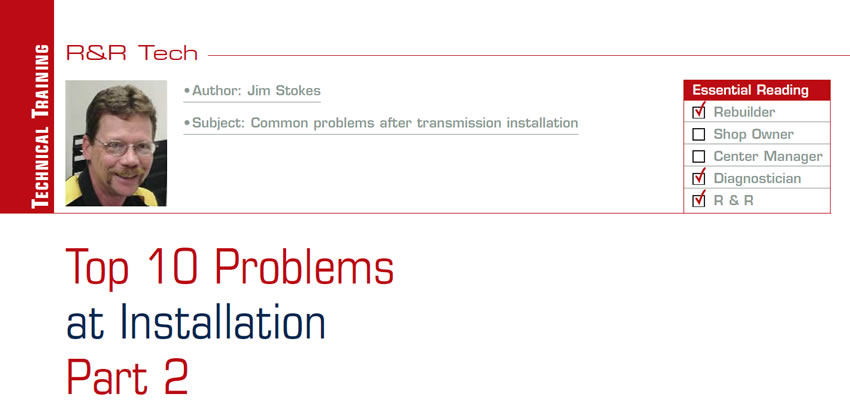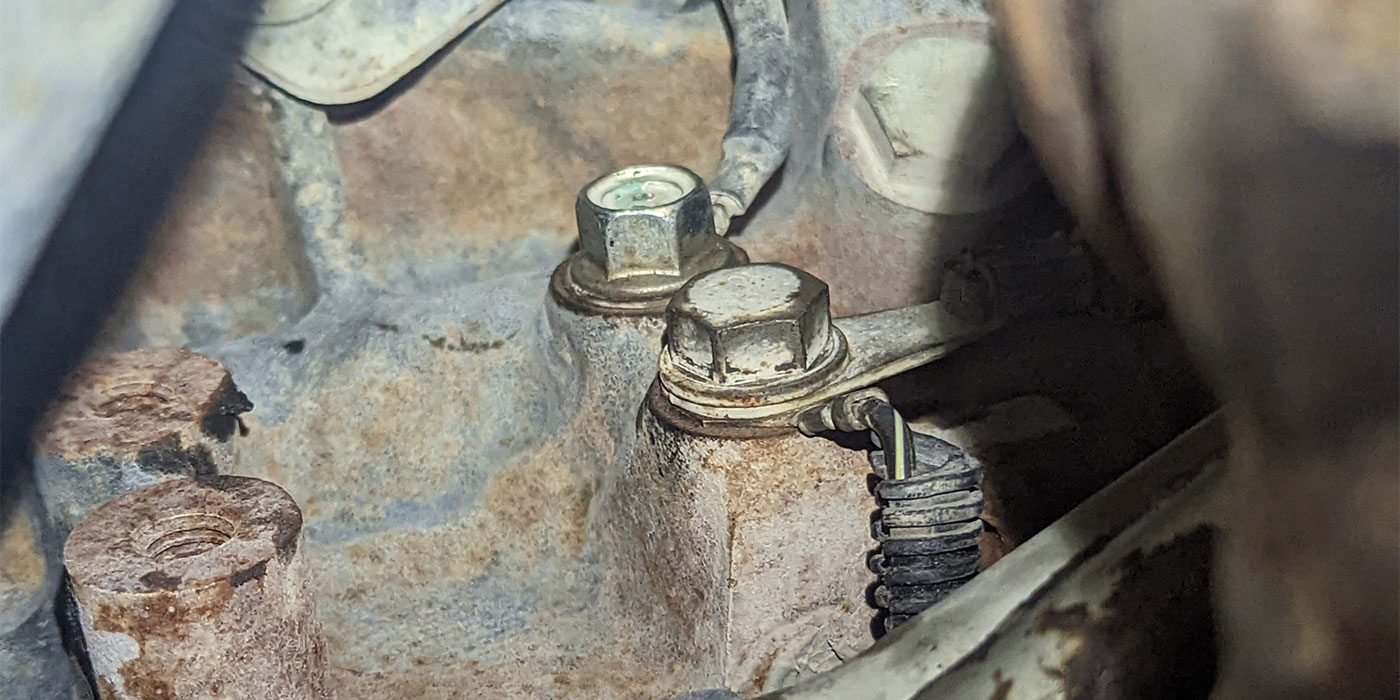
R&R Tech
- Subject: Common problems after transmission installation
- Essential Reading: Rebuilder, Diagnostician, R & R
- Author: Jim Stokes
Our company sells a large quantity of wholesale carry-out units in addition to performing in-house installations. We have a panel of technical advisers that provides guidance for both types of installations, and this article focuses on what we consider to be the top 10 issues that installers face today, based on the data we continually collect.
Number 4 – Electrical connectors
Vehicle harness connectors can have multiple problems, such as small to massive amounts of corrosion, loose pin fitment and fretting, broken lock tabs, and seized connectors that won’t unplug from the transmission connector.
E4OD/4R100 units seem to have the most connector problems, and with the exception of seizure they seem to have all the other concerns. The lock tab is easy to break and causes poor electrical contact, DTCs and overall performance problems. It isn’t uncommon to get a call about an electrical-circuit code. I will usually send a replacement solenoid pack when this happens to eliminate the transmission as a cause first. Often I get another call after the replacement solenoid pack is installed saying the same code has returned or there is a different circuit code. After some coaxing the customer will finally admit that the lock tab is broken from the harness. I see a lot of corrosion from these connectors also and it seems to be worse on the East Coast, but we recently had a customer in Iowa that had returned the “defective” solenoid pack and connector. It was so badly corroded that the pins in the solenoid pack were eaten away to nothing in a short four weeks.
Ford 5R55S/W/N units use a bolt-in connector that can be difficult to remove from the solenoid pack. We have heard of some shops successfully removing the connector with the help of a heat gun. When I last checked no replacement connectors were readily available in the aftermarket, and use of a Ford part requires replacement of the entire harness, as the connector is included with it.
Cross-connecting shift solenoids and sensors has been an ongoing issue for a while now but never seems to get any better. It could be assumed that, to save money by using the same connectors in multiple locations, the OE chooses to manufacture some cars in this fashion. I first ran into the problem about 16 years ago. I had replaced the engine harness and several sensors on a 1996 Accord that had an underhood fire. The engine would start but wouldn’t idle, or run even with the throttle applied. It turns out that I had the MAP sensor and the TPS cross connected. Hondas still have this problem today, because many of the shift solenoids and sensors use the same connector, as do the pressure switches. If they have the same pin count in the connector, it will plug into the wrong component and cause issues.
Mitsubishi and Hyundai vehicles also have the same problem, usually with (but not restricted to) the pulse generators. Mixing up these sensors can cause multiple issues, including no reverse, wrong-gear starts and no upshifts. Color-matching the harness connectors often will find the problem quickly, but not always.
Recently we had a 2008 Mazda Tribute that had a long, delayed reverse engagement and was hunting in and out of 2nd and 3rd gears. The vehicle had been driven only five miles after installation of the transmission. We were about to ask him to send the unit back to us, but then the customer revealed that the speedometer was reading much slower than it used to. It turned out that he had crossed the connectors for the input- and output-speed sensors. After that was corrected, the unit worked fine.
Having a component locator available to view along with a good wiring diagram will usually help sort out this type of problem in a short time.

Number 5 – Power and grounds
GM trucks with 4L60-E and 4L80-E transmissions seem to have many power-supply issues. Defective ignition switches are the normal cause of the problem, and we have seen a few vehicles with aftermarket products incorrectly wired into the power-supply circuit for the transmission. We suspect that misdiagnosis has resulted in many transmissions being sold for symptoms created by the bad ignition switches, as we have had several calls immediately after installation reporting a concern identical to the one in the unit that was just replaced. GM TSB 01-07-30-002A goes back to 1997, but we have seen the problem in 1994 models. The TSB has been updated to 01-07-30-002E to 2005 models, so it affects a lot of vehicles on the road today.
We have had several calls on Toyota vehicles that won’t start, won’t shift and have wrong-gear starts right after transmission replacement. A poor ground connection at the transmission case, and sometimes at the battery ground also, is often the cause. We have seen similar concerns in other vehicle makes. The most-prone vehicles have power-side-controlled systems, in which the PCM/TCM sends voltage to the solenoid being controlled and the solenoids are permanently grounded to the valve body. With this type of control system, ground cables are connected directly to the transmission case. These ground-cable connections are often used for PCM/TCM return signals, so they must be clean and secure.
All power and ground connections must be clean and free of excessive resistance. Since the battery is usually disconnected during installation of a unit, clean the connections before reconnecting them.
Number 6 – Engine sensors
Engine sensors have a big impact on transmission performance. MAF, TPS, oxygen, knock and coolant sensors are all potential trouble for the transmission’s operation.
We had a 2002 Buick Century with a freshly installed, remanufactured 4T65-E. It had slow, soft upshifts, and if heavy throttle was applied it would slip. It wasn’t driven long enough to set GRE codes, but it would have set codes if driven a significant distance. The installer was an industry veteran at a quality shop, so I sent him a replacement unit based on his own diagnosis. When the replacement unit was installed, it had the same problems as the unit just removed. He installed a pressure gauge and found that the unit had no line rise with increased engine load. He connected a scan tool and manually controlled the PC solenoid, and the pressures stayed in spec with each increased pressure command. After he replaced the MAF sensor, the unit worked as designed. The engine did not have any drivability concerns, and no DTCs set. Because the MAF was bad, incorrect load calculations from the PCM were causing a slip condition.
Engine-coolant-temperature sensors can cause 518/618 units to go in and out of lockup if they fluctuate around 160°F, where TCC engagement is allowed on. The same vehicles can have a no-upshift complaint or wrong-gear starts if the oxygen-sensor ground is lost or contaminated. The governor solenoid and the O2 sensors share grounds.
We recently had a 2000 Lexus RX300 that didn’t have 4th gear immediately after installation. After hours of unsuccessful diagnosis, it was discovered that the exhaust manifold was leaking near a knock sensor and caused the PCM to inhibit the shift. These same vehicles will not shift to 4th gear if a knock-sensor code is present.
Improper TPS signals will affect multiple vehicles, causing them to have soft or harsh upshifts and engagements, early shifts, slipping lockup clutches and shuddering.

Number 7 – Performance modifications
Applying modifications that result in a large increase to engine performance, but without modifying the transmission, will nearly always end badly. The easily added performance chip, download or module can add 100 or more horsepower and increase engine torque, but the factory has the original programming tuned to protect the OE transmission from damage. When that protection is removed, it usually ends badly for a stock-level transmission, but if the repairs are done correctly with the knowledge of the modification, it can be very profitable. Be careful of these vehicles, because without that knowledge it can be a costly mistake for the repair shop.
Number 8 – Converter bolts
Proper installation and usage of converter bolts is critical to avoiding a major failure. We have had units returned with converter dimpling problems from 4L60-E units, all Chrysler units, Toyota units, KM models and, most recently, a rash of AW55-51SN units in both Nissan and Volvo applications. Just the slightest dimple in the converter cover will eventually cause a clutch failure to occur. We have seen it happen anywhere from 10 to 7,000 miles of use; the end results are always the same. Verify that the correct, OE-spec bolts are used in all mounting holes, since it takes only one incorrect bolt to cause failure, Also, use a torque wrench when tightening the converter bolts.
Number 9 – Seals
A remanufactured or rebuilt unit will have all new seals installed, preferably with the best quality available. All seals should be installed with alignment tools that keep them straight and in alignment, and if it is a metal-clad seal the metal portion should be sealed to the case and installed with the proper tool that sets them to the correct depth. A word of caution: Inspect yokes and axles carefully for damage and wear before installing them, and be careful not to bang into them when installing a unit.
Number 10 – Cooler cleaning and contamination
Proper cooler cleaning is a problem for the remanufacturing industry – not so much with professional transmission-shop installations, but with the general-repair shops that do not have access to the proper equipment for flushing modern transmission-oil coolers.
Another problem we see often is fluid contamination originating from dirty coolers, and intrusion through the vents. Ford has issued TSB 05-23-7 for 1999-2003 Windstar and 2004-06 Freestar vehicles for water getting into the units through the vent. Water is misrouted from the cowl under the windshield and ends up in the transmission vent. The cowl requires modification to correct the condition, and I would also suggest adding a hose to the vent to relocate it and have it face downward, if possible. We have seen many units damaged from water intrusion in both cores and returned failed units.

Jim Stokes is a warranty technician with Certified Transmission. He has been a service writer and diagnostician, has helped run stores and has been a part of the warranty team for almost 10 years.













